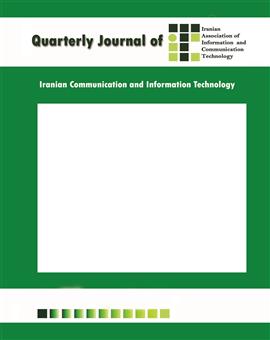A design of Rectangular Waveguide TM11 to TE10 Mode Converter for S-band Applications
Subject Areas : ICTHamed noroozy 1 * , Hossein Chabok 2 , Samane Pakniyat 3
1 -
2 -
3 -
Keywords: Mode converter, S-band applications, TM11 to TE10 mode conveter, high power microwave (HPM) applications,
Abstract :
A design of a compact, easy to fabricate and applicable structure rectangular waveguide TM11 to TE10 mode converter is presented in this paper. The design procedure of the proposed structure can be divided into two parts in sequence. The beginning one is dedicated to the transformation from TM11 to TEM mode using a central conductor, while the second part is the transformation from TEM to TE10 mode using a dielectric loaded waveguide carrying out 180o phase shift. The proposed structure has the advantage of high efficiency of above 90 %, which are demonstrated in simulation results
[1] A. Chittora, J. Mukherjee, S. Singh and A,Sharma, “Dielectric Loaded TM01 to TE11 Mode Converter for S-band Applications,” IEEE Trans. Dielectrics and Electrical insulation, vol. 22, pp. 2057-2063, August 2015.
[2] A. Tribak, J. Zbitou, A. Mediavilla, A,Sharma and NA. Touhami, “Ultra-broadband High Efficiency Mode Converter ,” Progress in Electromagnetics Research, vol. 36, pp. 145-158, January 2013.
[3] R. L. Eisenhart , “A Novel Wideband TM01-to-TE11 Mode Converter,” Microwave Symposiun Digest, vol. 1, 1998, pp. 249–252.
[4] K.S.S. Prasad, S.A. Singh, S.S. Shanmukha, R. Seshdri and M.V. Kartikeyan “Design of a TM01-TE11 Circular Bend Mode Converter Operating at 3GHz,” IEEE International Vacuum Electronics Conf., pp. 177-178, February 2011.
[5] S.H. Lee, B.M. Lee, J.Ahn, Y.J. Yoon and J.H. So “The Design of X-band Non-constant Serpentine TM01-TE11 Mode Converter with Short Length,” Asia-Pasific Microwave Conf., Vol. 1, pp. 4, 2005.
[6] B.M. Lee, W.S. Lee, Y.J. Yoon, J.H. So, “X-band TM01-TE11 Mode Converter with Short Length for High Power,” Electronics Letts, vol. 40, No. 18, pp. 1126-1127, 2004.

